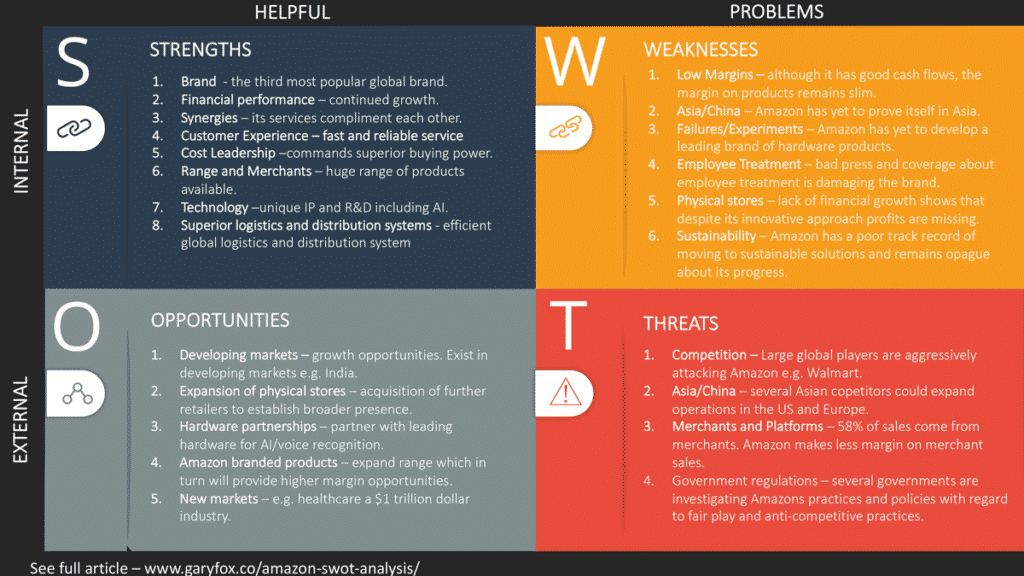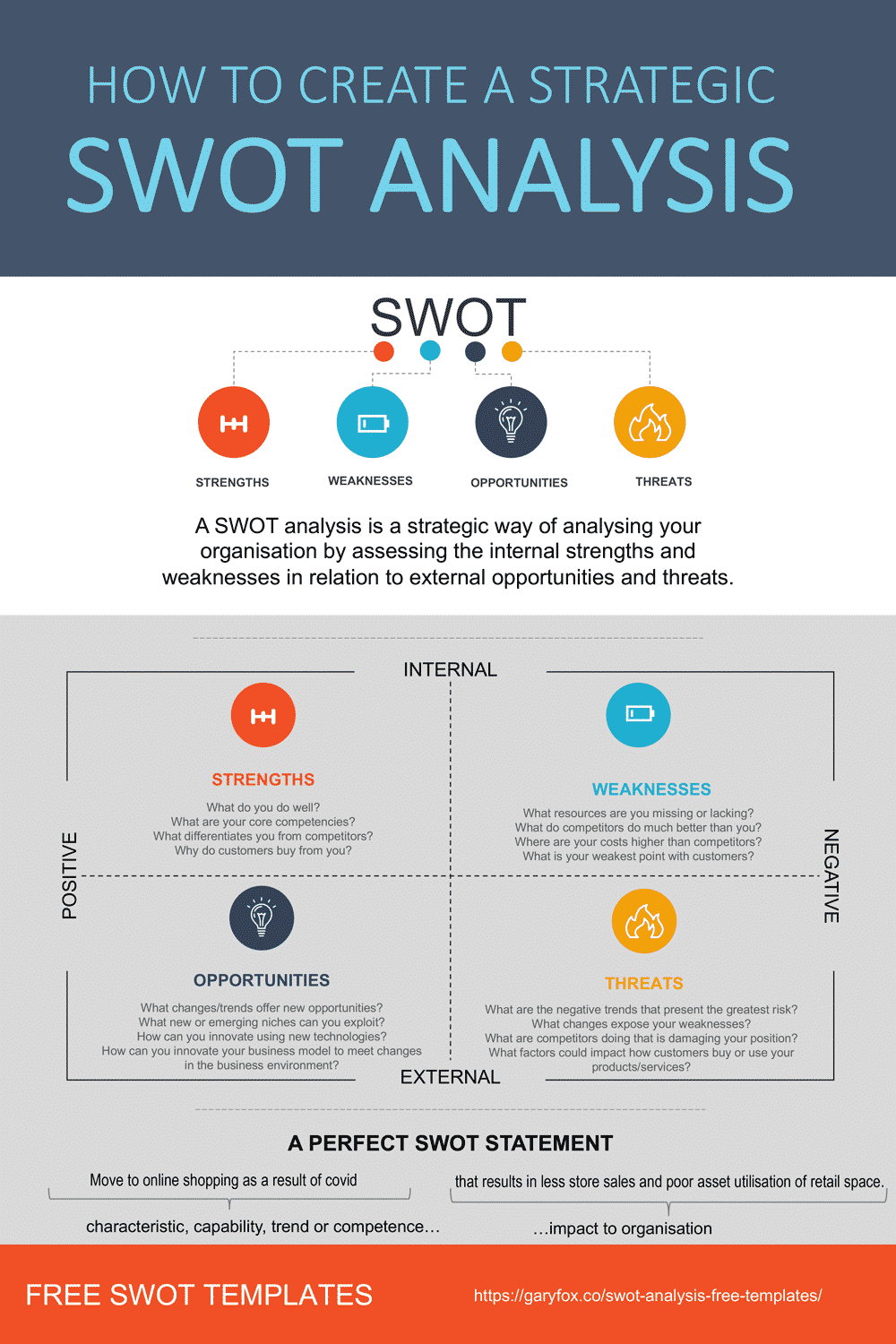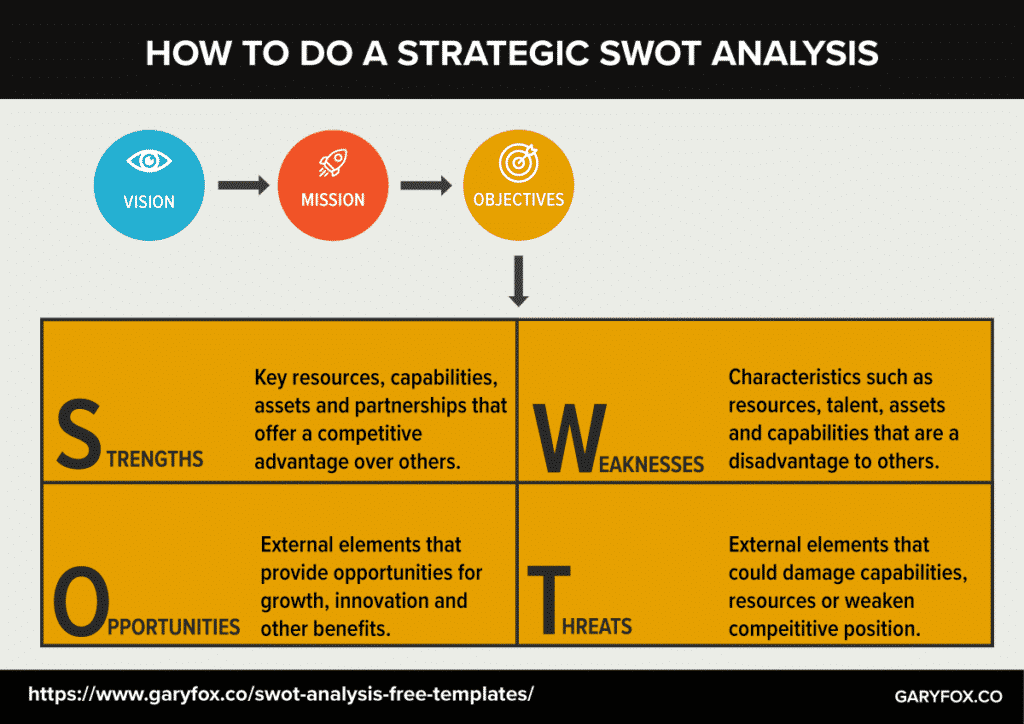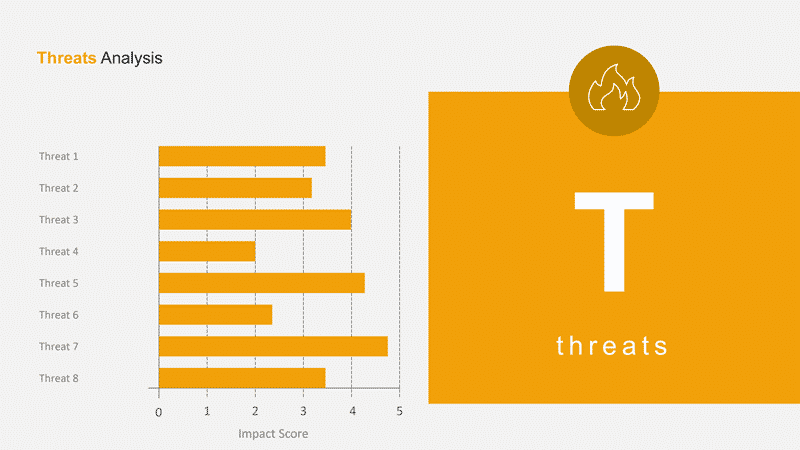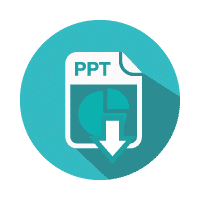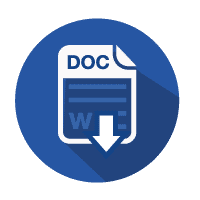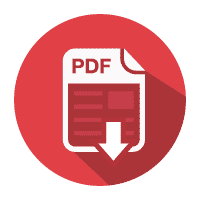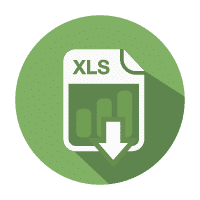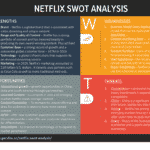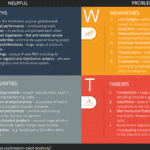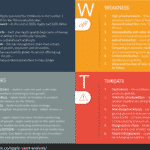A SWOT analysis is a powerful way tool to guide decision-making.
In this article, I’ll cover the common mistakes made that can lead to poor strategies and the power tips that can significantly boost your success.
In addition, you’ll get free SWOT analysis templates in PowerPoint, Word, Pdf and Excel. You can choose the SWOT analysis templates that best fits to your needs.
A SWOT analysis is only as good as the information that you use to create it. Research and up-to-date data is vital to identify key issues in the business environment.
What is a SWOT Analysis?
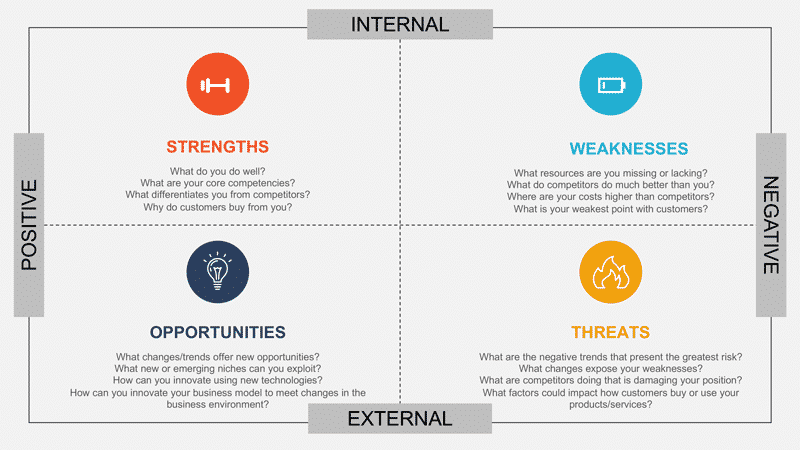
SWOT stand for strengths, weaknesses, opportunities and threats.
In simple terms, a SWOT analysis is used to assess how your internal capabilities match the external environment.
The SWOT Analysis is a strategic planning tool used to evaluate an organization, a plan or a business activity.
A SWOT Analysis has two dimensions: Internal and External:
- External analysis offers insights into the opportunities and threats your business may face.
- Internal analysis will reveal what are your core strengths and weaknesses.
The external environment consists of all the factors that are outside of the firm. External factors are usually things that the firm has little or no control over.
In contrast, the internal analysis – strengths and weaknesses, reflects all the parts of the firm that can be managed. The ‘internal’ characteristics of a firm though are still complex and varied e.g. talent, intellectual property, assets, partners, technologies…
However, throwing everything into the SWOT will create a poor quality analysis. The art of strategy is to understand what are the priorities, the important parts of both internal and external capabilities to focus on.
Why Do a SWOT Analysis?
A SWOT analysis arms management teams with knowledge they need to develop strategies that will provide future growth as well as mitigate any threats and compensate for weaknesses.
A SWOT is only one part of the strategy and ultimately other factors come into play.
A SWOT can be used to assess capabilities, resources, partnerships and so provides valuable insights into an organisations business model.
Just because an organisation has defined it’s business model doesn’t mean it is still relevant or competitive. Business models change within markets, and new business models emerge. Quite often, business models are adapted and incrementally change.
Part of the strategic planning process is to assess the need for business model innovation.
SWOT Definitions
What is an opportunity in a SWOT analysis?
An opportunity is a situation or condition that if seized upon can offer an advantage to an organisation. It becomes a driving force for an organisation to allocate resources and undertake activities that then turn these into profits and growth. An opportunity then is a promise of future potential.
What is a threat in a SWOT analysis?
What is a weakness in SWOT analysis?
A weakness refers to a firm lacking in skills, resources and capabilities. Although weaknesses can be individual they can also be compounded. As an example, if competitors are aggressively pursuing the use of AI then a firm might be weak because of lack of talent as well as lacking in the technology itself. The main takeaway is that a weakness is relative to what the firm wants to achieve, its goals, and compared to competitor capabilities.
What is a strength in a SWOT analysis?
A strength is some thing that the firm does well, usually better than the competition. Strengths are positive, favourable capabilities, resources or skills that play a critical role in achieving the goals of the firm. Strengths, like weaknesses, can be tangible or intangible. Tangible strengths are things that are easily measured such as cash flow, financial ratios, assets…Intangible strengths often reflect things like tacit knowledge in a firm (the way we do things) or another example is the power of a brand in a market – brand equity.
5 Steps To Create A Powerful SWOT Analysis
Pulling together information and data to create a SWOT can seem quite daunting.
How to do a SWOT analysis the right way.
Step 1 – Conduct a PESTEL analysis
A PESTEL analysis will reveal the big macro factors that are shaping changes in your business environment. PESTEL stands for Political, Economic, Social, Technological, Environmental and Legal factors.Each industry and market is different so there are no hard and fast rules for which of these is more important or relevant.As an example, if you are a bank then legal, economic and regulatory factors are a significant factors that will influence your SWOT.Gather data and identify changes and trends in the short, mid and long-term.
Step 2 – Analyse the Competition
Draw up a list of your main competitors.Compare them on key measures such as market share, range of products, value proposition, brand positioning, innovation capabilities, technologies. Don’t forget to also analyse substitutes products or services.
Step 3 – Analyse the Market/Customer
What are the trends in the market? What new business models are emerging? How are customers (B2C) or buyers (B2B) changing?
Step 4 – Assess Internal Strengths and Weaknesses
There are lots of different methods and tools to use to assess your internal strengths and weaknesses. Often I find firms using strategic scorecards and key performance indicators. They measure themselves against these but tend to not think outside the box. They have become narrow in their view of their strengths and weaknesses.A good tool to assess internal strengths and weaknesses is to start with a VRIO analysis. The VRIO tool reviews internal resources of an organisation and categorises each based on overall value to the organisation. Another tool is McKinsey 7s, McKinsey 7S prompts you to analyse 7 internal aspects of your organisation: Structure, Systems, Shared Values, Skills, Style and Staff.Tip: when analysing strengths and weaknesses remember to assess and evaluate intangible factors as well as tangible.
Step 5 – Complete The SWOT Analysis
Now that you have all the data you need – external and internal you’re ready to add this into the SWOT and create the full analysis. By matching strengths to opportunities you can create a strategic advantage. By developing strategies to mitigate risks from threats that expose weaknesses you can avoid future risks.
Of course, once you’ve developed a strategy once it gets easier to gather data and develop a SWOT.
How do you identify external opportunities and threats?
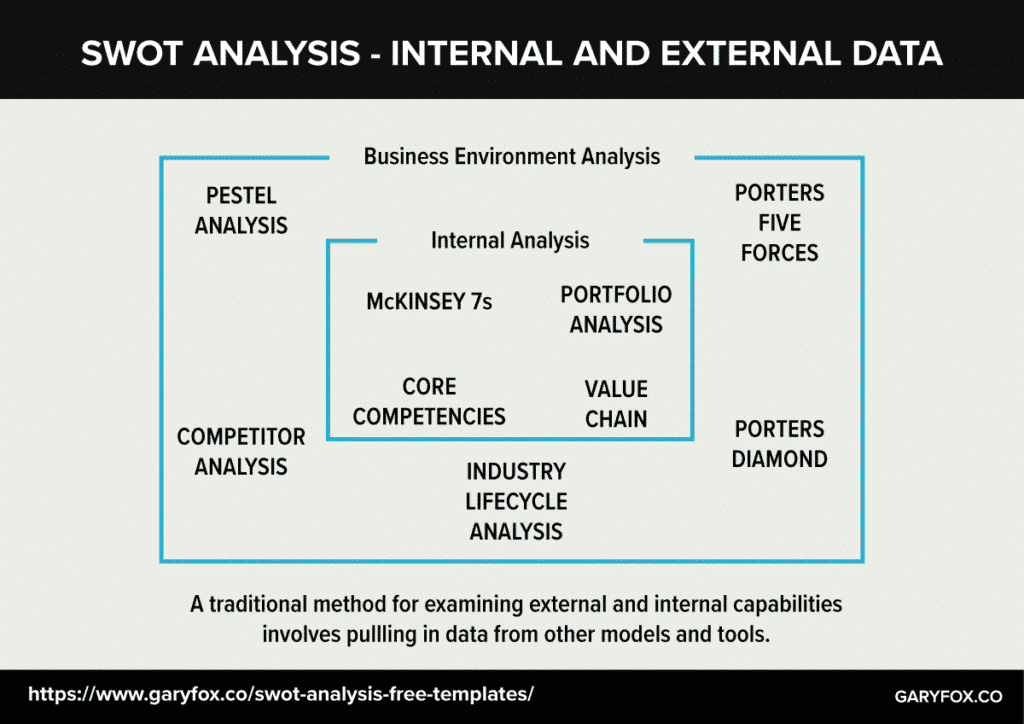
A SWOT analysis requires you to pull in information from other research to get a picture of the opportunities and threats.
The most common tools managers use are:
- Porters Five Forces
- PESTEL analysis
- Competitor analysis
- Porters Diamond
- Industry lifecycle
It’s important to recognise that the business environment is a fluid, constantly changing and so any analysis is just a snapshot in time.
By the time you have got ready to conduct a SWOT analysis you should already have a picture of the most important priorities.
Examples of External Opportunities and Threats
Societal Changes
- Changes in customer preferences and behaviours that impact product demand or design.
- Population trends that impact distribution, sales and/or design.
Governmental Changes
- New legislation that impacts production, distribution, operations, recruitment, sales and marketing. Recent examples, Covid rules on opening hours, social distancing, GDPR regulations…
- New policies or priorities from a government to stimulate economic growth.
- Tax breaks for types of companies that invest in localised areas.
Market Changes
- New uses of product impacting demand
- Substitute products/services impacting market share
- Product obsolescence impacting portfolio
- Mergers and acquisitions impacting competitor position/buying power
Economic Changes
- Change in interest rates
- Change in exchange rates
- Change in international trade regulations
- Recession/inflation
Competitive Changes
- Adoption of new technologies impacting cost position
- New competitors impacting business model, prices, market share, margins…
- Price changes impacting margins
Supplier Changes
- Changes in materials impacting demand, capacity utilisation…
- Supply chain changes impacting production processes
- Changes in suppliers impacting availability
How to identify internal strengths and weaknesses.
The following are examples of tools that can be used to analyse your organisations strengths and weaknesses to develop a realistic strategy. The tools you use will depend on your current capabilities to analyse and evaluate your internal environment.
Interviews
Often I find that executive teams are missing critical information regarding strengths and weaknesses. With limited time and demanding roles they are often focusing on high level critical decisions.
On the ground floor and across the organisation there are clues and insights that are invaluable when assessing internal strengths and weaknesses.
By taking a sample set of interviews from across different business units and levels often provides much needed data. As an example, customer service teams can give you details of what customers are saying/complaining about, sales teams often have a deep knowledge of specific competitors and tactics.
McKinsey 7s
McKinsey has created many strategy tools to help in the strategy process.
The 7S framework is solid straightforward tool was featured in the excellent book, In Search of Excellence, by former McKinsey consultants Thomas J. Peters and Robert H. Waterman.
It helps you get to understand the factors that influence an organisation’s ability to change.
Core Competencies
The Core Competency framework is an ideal tool to assess the specific characteristics that make an organisation unique and different from others in its sector. One of the benefits of this tool is that it assesses knowledge, skills and capabilities that result from them.
A ‘competency framework’ is a method that defines competency at an individual as well as aggregate level e.g. problem-solving. Competencies help to understand the behaviours, attitudes and activities that then deliver the output effectively.
Portfolio Analysis
A portfolio analysis will help you evaluate existing products and services and score them. Mapping your services in this way will identify which products or services are profitable, the stage of their lifecycle and whether they represent a strength or weakness.
Benchmarking
Unless you know how others are performing you might have a distorted view of your own capabilities – strengths and weaknesses.
Benchmarking is a systematic approach to identify best practices that other businesses, including your competitors, use to achieve a high performance level. By benchmarking, you quickly identify areas for improvement (weaknesses) and learn how and what needs to be changed to achieve best practice.
Examples of Internal Strengths and Weaknesses
Marketing
- Product quality
- Number of product lines
- Product differentiation
- Market share
- Pricing
- Distribution channels
- Customer service
- Customer churn
- Marketing research
- Customer experience
- Customer Relationship Management
- Marketing technology
- Digital media
- Social media
Business Model
- Differentiated business model
- Unique value proposition
- Unique resources
- Unique set of partnerships
- Well defined customer segments
- Cost model
- Pricing model
Operations
- External partners
- Sourcing
- Cost structure
- Inventory control
- Facilities and equipment
- Efficiency
- Capacity
- Agility
Employee
- Employee turnover
- Employee capabilities
- Employee morale
- Employee development
- New ideas put forward
- Job applications
- Number of employees to revenue/profits
- Agility level
- Organizational structure
- Accountability
- Autonomous vs Hierarchical decision making
Technology
- Digital transformation capabilities
- Agility of organization
- Quality of market/customer information
- Business intelligence information
- Big data analytics
- AI driven decisions
- E-commerce
- Customer personalisation
Innovation
- Innovation capabilities
- Speed to market
- Success of innovation(s)
- Percentage of sales/profits from new products/services
- Number of active projects
Management Team
- Product quality
- Number of product lines
- Product differentiation
- Market share
- Pricing
- Distribution channels
- Customer service
- Marketing research
- Customer experience
- Customer Relationship Management
- Marketing technology
- Digital media
- Social media
Finance
- Financial leverage
- Operating leverage
- Balance sheet ratios
- Ratio of net cash to capital expenses
- Credit rating
- Age of debt / due date
- Share value
- Market Cap
How to Use Your SWOT Analysis
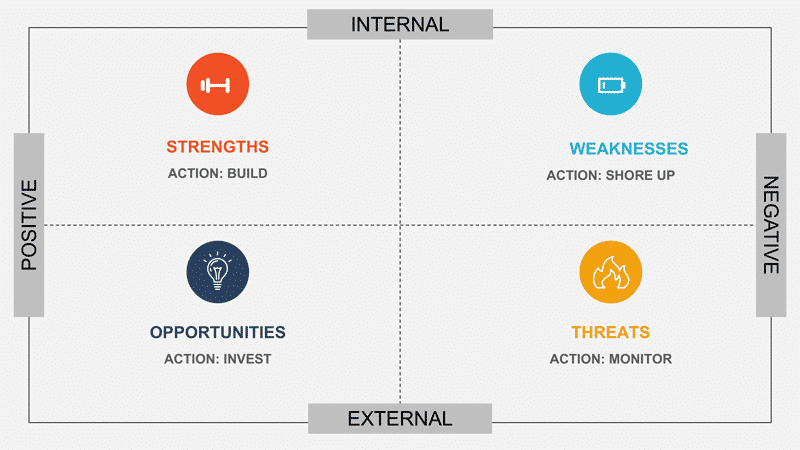
The first and most important part of using a SWOT analysis is to use it. Do not simply run through it as an exercise and then abandon it.
Getting good at strategic planning takes time and effort. But by making it part of your organisational culture, your way of doing things you will rapidly see the benefits.
Management and teams will have a much higher level of sense-making, the ability to understand complexity and distill it into actions and outcomes.
A SWOT is NOT separate or divorced from other planning processes such as OKR – see the OKR guide.
Free SWOT Templates To Download (No Sign-up Required)
Free SWOT Analysis PowerPoint Template
The Free SWOT analysis PowerPoint template is available without any need to sign-up. Please download and if you have any ideas for improvement please contact me.
Free SWOT Analysis Word Template
The Free SWOT Analysis Word Template contains a basic SWOT template that is a useful when building your overall strategy document.
Free SWOT Analysis Pdf Template
The Free SWOT Analysis Pdf template allows you to quickly sketch out your ideas – use it in workshops – online or offline.
Free SWOT Analysis Excel Template
The free MS Excel SWOT Analysis template has three tabs with different ways to use a SWOT.
SWOT Analysis Examples
Here are a few examples of SWOT’s that I’ve produced. Note these are from an outside-in perspective and therefore reflect more of an analysis a competitor might undertake.
Read the full Tesla SWOT Analysis.
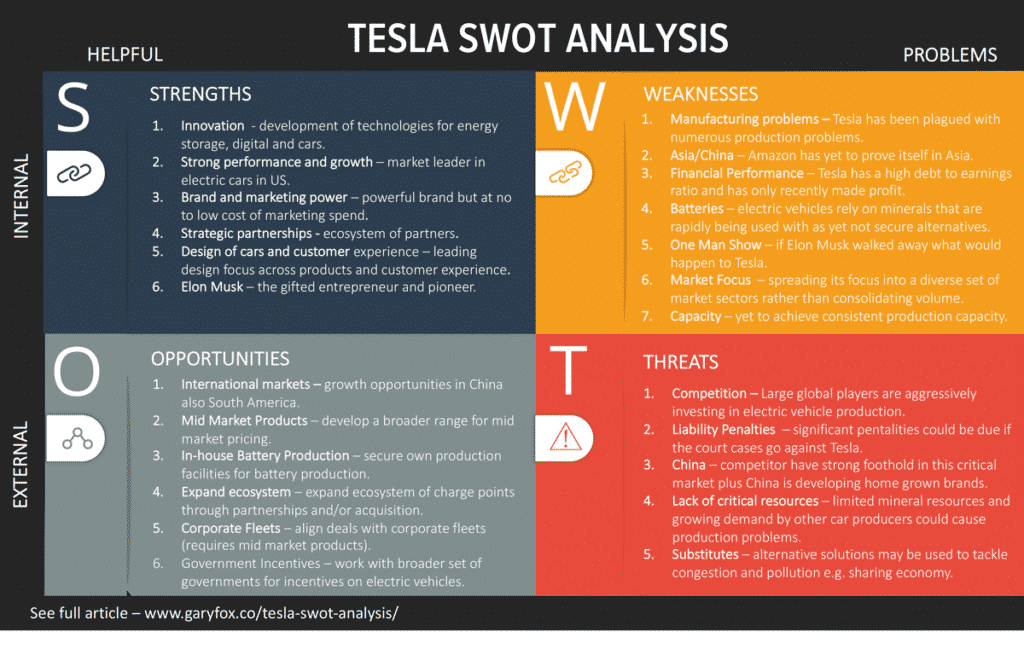
Read the full Apple SWOT analysis.
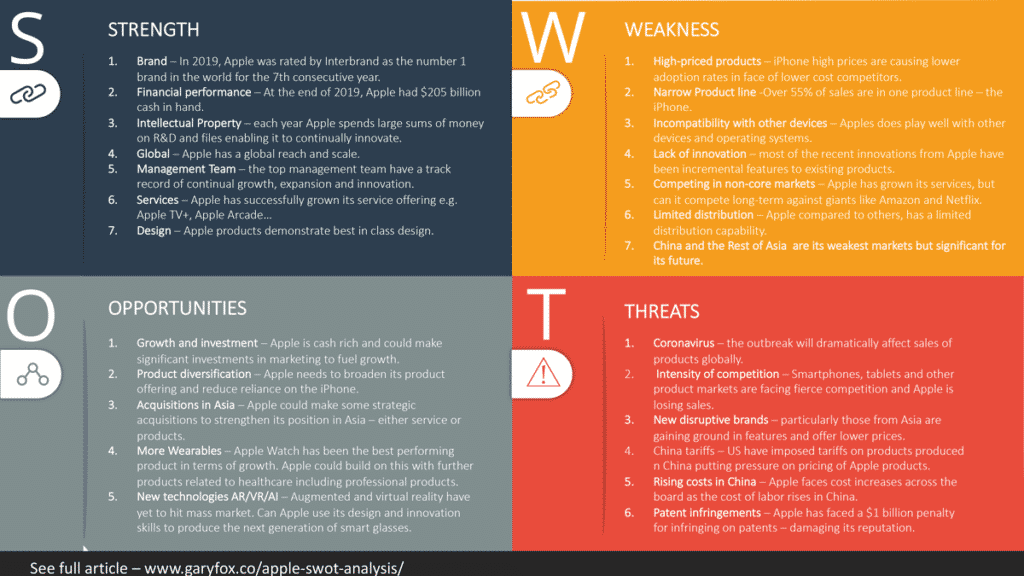
Read the full Amazon SWOT Analysis.
